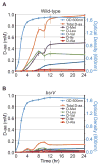D-amino acids govern stationary phase cell wall remodeling in bacteria
- PMID: 19762646
- PMCID: PMC2759711
- DOI: 10.1126/science.1178123
D-amino acids govern stationary phase cell wall remodeling in bacteria
Abstract
In all known organisms, amino acids are predominantly thought to be synthesized and used as their L-enantiomers. Here, we found that bacteria produce diverse D-amino acids as well, which accumulate at millimolar concentrations in supernatants of stationary phase cultures. In Vibrio cholerae, a dedicated racemase produced D-Met and D-Leu, whereas Bacillus subtilis generated D-Tyr and D-Phe. These unusual D-amino acids appear to modulate synthesis of peptidoglycan, a strong and elastic polymer that serves as the stress-bearing component of the bacterial cell wall. D-Amino acids influenced peptidoglycan composition, amount, and strength, both by means of their incorporation into the polymer and by regulating enzymes that synthesize and modify it. Thus, synthesis of D-amino acids may be a common strategy for bacteria to adapt to changing environmental conditions.
Figures




Comment in
-
Cell biology. Expanding functionality within the looking-glass universe.Science. 2009 Sep 18;325(5947):1505-6. doi: 10.1126/science.1180332. Science. 2009. PMID: 19762631 No abstract available.
References
Publication types
MeSH terms
Substances
Grants and funding
LinkOut - more resources
Full Text Sources
Other Literature Sources
Molecular Biology Databases
Miscellaneous

